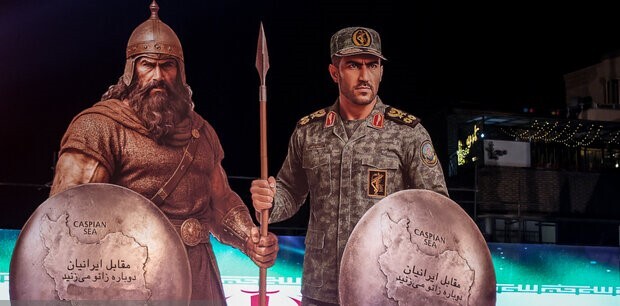
A recent cultural initiative by Tehran Beautification Organization has sparked renewed interest in the role of public art in shaping national identity, using the historic defeat of Roman Emperor Valerian by Shapur as its central narrative.
The campaign, titled “You Will Kneel Before Iran Again,” was launched with the aim of highlighting a moment of historic pride and strengthening a sense of collective confidence. At its core stands a symbolic sculpture unveiled in Tehran’s Enghelab Square, an artwork inspired by Shapur II’s victory over Valerian, designed not merely as an urban installation but as a visual statement about Iran’s longstanding resistance to foreign domination.
At a time when societies worldwide are seeking to redefine their cultural and historical identities, this campaign positions itself as a cultural and artistic effort to revive the themes of dignity, resilience, and historical continuity in public consciousness. By drawing on the power of public art, historical memory, and civic participation, it seeks to convey the idea of Iranian resilience in a way that resonates with everyday life.
The sculpture’s placement in a major urban hub marks the beginning of a broader effort to extend historical narratives into public spaces, moving them from textbooks to city squares. The initiative aims to transform history from an academic subject into a shared, lived experience, particularly for younger generations who may feel disconnected from traditional symbols of identity.
Beyond its artistic value, the campaign attempts to stimulate a wider national conversation about how history, identity, and collective memory intersect. Public symbols, when effectively designed and contextually rooted, can serve as cultural tools that encourage reflection on the past while shaping perspectives on the present.
From a historical perspective, the campaign revisits a moment deeply embedded in Iran’s cultural memory: Shapur II’s capture of Valerian, viewed not only as a military victory but as a symbol of Iranian civilizational strength in the face of imperial powers. Presenting this episode through public art is seen as a way to reinforce confidence, especially during periods of social and identity-related uncertainty.
From a sociological view, the initiative emerges at a time of economic pressure, and media hype. In such circumstances, visible representations of historical resilience can play a role in restoring a sense of unity and belonging. These symbols become meaningful when they transcend mere decoration and develop into shared reference points in daily life, contributing to social confidence and collective continuity.
Artistically, the campaign emphasizes the power of sculpture and visual symbolism in communicating complex concepts such as dignity, resistance, and identity. Public art naturally invites interaction: people encounter it on their way to work, during routine walks, or in the midst of social gatherings, forming unspoken dialogues with the artwork and its message. The effectiveness of such work depends on both aesthetic integrity and its ability to connect with the collective memory of the community.
Selecting the moment of Valerian’s defeat as the symbolic centerpiece was a deliberate artistic choice, relying on a historically charged event that conveys a clear message of steadfastness. By aligning artistic expression with cultural heritage, the campaign positions public art as a bridge between past and present.
Ultimately, “You Will Kneel Before Iran Again” illustrates how historical narratives, when communicated through accessible artistic forms, can become tools for national cohesion. More than a beautification effort, it creates a platform for social reflection on identity, perseverance, and Iran’s future. Its continuation, especially in regions with strong traditions of resistance, could deepen the cultural impact and widen the reach of its message on a national scale.
The petroglyph of Shapur's victory over the Roman emperors is one of the surviving works from the Sassanid period, carved on a rock ledge in the Naqsh-e Rostam area, near the tomb of Darius the Great.
Source: Mehr